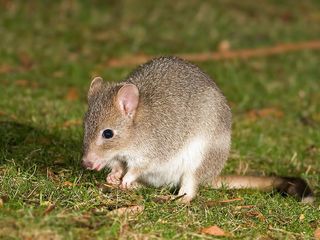
Author: JJ Harrison (jjharrison89@facebook.com)
Tasmanian bettong
Order : Diprotodontia
Family : Potoroidae
Species : Bettongia gaimardi
Keywords: red
The Eastern bettong, tasmanian bettong, tasmanian rat kangaroo is listed as Near Threatened (LR/nt), is close to qualifying for or is likely to qualify for a threatened category in the near future, on the IUCN Red List of Threatened Species
Countries
AustraliaSome facts about the
Tasmanian bettong
Adult weight : 1.725 kg (3.795 lbs)
Female maturity :252 days
Male maturity : 272 days
Gestation : 20 days
Weaning : 161 days
Litter size : 1
Interval between litters : 107 days
Weight at weaning : 0.789 kg (1.7358 lbs)
Basal metabolic rate : 4 W
Body mass : 1.385 kg (3.047 lbs)
Temperature : 35.85 °C (96.53 °F)
Facts about the Tasmanian bettong
The Tasmanian Bettong Bettongia gaimardi is a highly mycophagous species eating underground (hypogean) fungi. (Full text)
The Tasmanian bettong (Bettongia gaimardi) is a small rat kangaroo without detectable brown adipose tissue (BAT). (Full text)
The Tasmanian bettong (Bettongia gaimardi) is listed as PRESUMED EXTINCT on the schedules of the NSW Threatened Species Conservation Act.
in a Marsupial (the Tasmanian Bettong Bettongia gaimardi) Is Not Attributable to Brown Adipose Tissue Yong, AC
The Tasmanian bettong (Bettongia gaimardi) is a small marsupial able to increase its metabolic rate by non-shivering thermogenesis.
The long-nosed potoroo (Potorous tridactylus) is widespread on Tasmania, whereas the Tasmanian bettong (Bettongia gaimardi) is restricted to dry sclerophyll forest in eastern Tasmania, and the little pygmy possum (Cercartetus lepidus) prefers dry sclerophyll forest as well. (Full text)
The Tasmanian bettong, Bettongia gaimardi, is never a target species but has been shown to be sensitive to and adversely affected by 1080 baits (Statham 1984, Driessen et al.
The Tasmanian bettong, Bettongia gaimardi, is never a target species but has been shown to be sensitive to and adversely affected by 1080 baits (Statham 1984, Driessen et al. (Full text)
Nonshivering thermogenesis in a marsupial, the Tasmanian bettong (Bettongia gaimardi) is not attributable to brown adipose tissue. (Full text)
The Tasmanian bettong is an endemic rat-kangaroo (see Figure 1) that is the largest of the four species in this genus (5); it lives at altitudes between sea-level and 1000 metres (6). (Full text)
25 kg Status Common The Tasmanian bettong is probably the most secure of all the bettong genus, it is probably extinct on mainland Australia due to the introduction of feral cats and foxes.
25 kg Status Common The Tasmanian bettong is probably the most secure of all the bettong genus, it is probably extinct on mainland Australia due to the introduction of feral cats and foxes. (Full text)
25 kg Status Common The Tasmanian bettong is probably the most secure of all the bettong genus, it is probably extinct on mainland Australia due to the introduction of feral cats and foxes. (Full text)
More animals beginning with T
